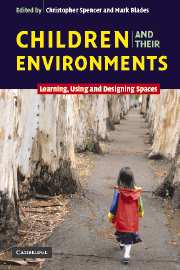Book contents
- Frontmatter
- Contents
- Notes on contributors
- An introduction
- Part I Children's understanding of places
- 1 Scale in children's experience with the environment
- 2 The problem of lost children
- 3 Children's understanding of environmental representations: aerial photographs and model towns
- 4 Children's knowledge of countries
- Part II Children's experience of places
- Part III Adolescents' worlds?
- Part IV Children and the design process
- Index
- References
2 - The problem of lost children
Published online by Cambridge University Press: 23 October 2009
- Frontmatter
- Contents
- Notes on contributors
- An introduction
- Part I Children's understanding of places
- 1 Scale in children's experience with the environment
- 2 The problem of lost children
- 3 Children's understanding of environmental representations: aerial photographs and model towns
- 4 Children's knowledge of countries
- Part II Children's experience of places
- Part III Adolescents' worlds?
- Part IV Children and the design process
- Index
- References
Summary
Ken Hill has been living with the ghost of a nine-year-old Nova Scotia boy for over eighteen years. Hill can picture Andrew Warburton as he was on a sunny day in July 1986 when he was enjoying activities near his aunt's rural home. Dressed in swimming trunks, a tank top, and sneakers, he independently set off to meet his older brother at a lake several hundred meters from the house. Although he had previously walked the path with playmates, Andrew disappeared in the forest on his way to the lake. A massive search effort resulted, ultimately involving over 5,000 community volunteers, fire fighters, and military personnel. The police search manager called the nearby university and asked for a psychologist who knew anything about children's spatial behaviour. Professor Ken Hill agreed to meet the search manager at the incident command post. Hill was asked to indicate on a map of the surrounding environment where search efforts should be focused. Hill remembers that he could think of nothing in the sizable literature on the development of children's spatial representation that applied to this problem. It was obvious that Hill had little to offer, and as the co-ordinators of the search continued to converse among themselves, Hill slipped away from the post to join one of the ground search teams. After eight days of the search effort, Andrew Warburton was found dead from hypothermia, approximately 3.2 km from the place where he had last been seen.
- Type
- Chapter
- Information
- Children and their EnvironmentsLearning, Using and Designing Spaces, pp. 26 - 41Publisher: Cambridge University PressPrint publication year: 2006
References
- 7
- Cited by

